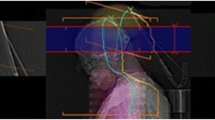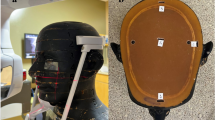Abstract
In cone-beam computed tomography (CBCT) for image-guided radiation therapy (IGRT) of the head, we evaluated the exposure dose reduction effect to the crystalline lens and position-matching accuracy by narrowing one side (X2) of the X-ray aperture (blade) in the X-direction. We defined the ocular surface dose of the head phantom as the crystalline lens exposure dose and measured using a radiophotoluminescence dosimeter (RPLD, GD-352 M) in the preset field (13.6 cm) and in each of the fields when blade X2 aperture was reduced in 0.5 cm increments from 10.0 to 5.0 cm. Auto-bone matching was performed on CBCT images acquired five times with blade X2 aperture set to 13.6 cm and 5.0 cm at each position when the head phantom was moved from − 5.0 to + 5.0 mm in 1.0 mm increment. The maximum reduction rate in the crystalline lens exposure dose was − 38.7% for the right lens and − 13.2% for the left lens when blade X2 aperture was 5.0 cm. The maximum difference in the amount of position correction between blade X2 aperture of 13.6 cm and 5.0 cm was 1 mm, and the accuracy of auto-bone matching was similar. In CBCT of the head, reduced blade X2 aperture is a useful technique for reducing the crystalline lens exposure dose while ensuring the accuracy of position matching.









Similar content being viewed by others
Data availability
Data sharing not applicable to this article as no datasets were generated or analyzed during the current study.
Change history
15 May 2024
A Correction to this paper has been published: https://doi.org/10.1007/s12194-024-00812-y
References
ICRP. The 2007 Recommendations of the International Commission on Radiological Protection. ICRP Publication 103. Ann. ICRP 2007; doi: https://doi.org/10.1016/j.icrp.2007.10.003
ICRP publication 118: ICRP statement on tissue reactions and early and late effects of radiation in normal tissues and organs-threshold doses for tissue reactions in a radiation protection context. Ann. ICRP 2012. doi: https://doi.org/10.1016/j.icrp.2012.02.001
Nakashima E, Neriishi K, Minamoto A. A reanalysis of atomic-bomb cataract data, 2000–2002: a threshold analysis. Health Phys. 2006. https://doi.org/10.1097/01.hp.0000175442.03596.63.
Neriishi K, Nakashima E, Minamoto A, et al. Postoperative cataract cases among atomic bomb survivors: radiation dose response and threshold. Radiat Res. 2007. https://doi.org/10.1667/RR0928.1.
Marcus KJ, Goumnerova L, Billett AL, et al. Stereotactic radiotherapy for localized low-grade gliomas in children: final results of a prospective trial. Int J Radiat Oncol Biol Phys. 2005. https://doi.org/10.1016/j.ijrobp.2004.06.012.
Monjazeb AM, Ayala D, Jensen C, et al. A phase I dose escalation study of hypofractionated IMRT field-in-field boost for newly diagnosed glioblastoma multiforme. Int J Radiat Oncol Biol Phys. 2012. https://doi.org/10.1016/j.ijrobp.2010.10.018.
Habets EJJ, Dirven L, Wiggenraad RG, et al. Neurocognitive functioning and health-related quality of life in patients treated with stereotactic radiotherapy for brain metastases: a prospective study. Neuro Oncol. 2016. https://doi.org/10.1093/neuonc/nov186.
Hoppe BS, Stegman LD, Zelefsky MJ, et al. Treatment of nasal cavity and paranasal sinus cancer with modern radiotherapy techniques in the postoperative setting–the MSKCC experience. Int J Radiat Oncol Biol Phys. 2007. https://doi.org/10.1016/j.ijrobp.2006.09.023.
Bragga CM, Wingate K, Conway J. Clinical implications of the anisotropic analytical algorithm for IMRT treatment planning and verification. Radiother Oncol. 2008. https://doi.org/10.1016/j.radonc.2008.01.011.
Liu X, Huang E, Wang Y, et al. Dosimetric comparison of helical tomotherapy, VMAT, fixed-field IMRT and 3D-conformal radiotherapy for stage I-II nasal natural killer T-cell lymphoma. Radiat Oncol. 2017. https://doi.org/10.1186/s13014-017-0812-1.
Kan MW, Leung LH, Wong W, et al. Radiation dose from cone beam computed tomography for image-guided radiation therapy. Int J Radiat Oncol Biol Phys. 2008. https://doi.org/10.1016/j.ijrobp.2007.08.062.
Zhou L, Bai S, Zhang Y, et al. Imaging Dose, Cancer risk and cost analysis in image-guided radiotherapy of cancers. Sci Rep. 2018. https://doi.org/10.1038/s41598-018-28431-9.
Özseven A, Dirican B. Evaluation of patient organ doses from kilovoltage cone-beam CT imaging in radiation therapy. Rep Pract Oncol Radiother. 2021. https://doi.org/10.5603/RPOR.a2021.0038.
Ding GX, Alaei P, Curran B, et al. Image guidance doses delivered during radiotherapy: Quantification, management, and reduction: Report of the AAPM Therapy Physics Committee Task Group 180. Med Phys. 2018. https://doi.org/10.1002/mp.12824.
Zhang Y, Wu H, Chen Z, et al. Concomitant imaging dose and cancer risk in image guided thoracic radiation therapy. Int J Radiat Oncol Biol Phys. 2015. https://doi.org/10.1016/j.ijrobp.2015.06.034.
Ding GX, Munro P, Pawlowski J, et al. Reducing radiation exposure to patients from kV-CBCT imaging. Radiother Oncol. 2010. https://doi.org/10.1016/j.radonc.2010.08.005.
International Electrotechnical Commission. 2011. IEC 61217 Radiotherapy equipment - Coordinates movements and scales: International Electrotechnical Commission, Geneva, Switzerland
Seltzer SM, Hubbell JH. Tables of X-ray mass attenuation coefficients and mass absorption coefficients 1 keV to 20 MeV for elements Z=1 to 92 and 48 additional substances of dosimetric interest (NISTIR 5632). Washington, D.C.: National Institute of Standards and Technology; 1995.
Hsu SM, Yang HW, Yeh TC, et al. Synthesis and physical characteristics of radiophotoluminescent glass dosimeters. Radiat Meas. 2007. https://doi.org/10.1016/j.radmeas.2007.01.053.
Kim JS, Park BR, Yoo J, et al. Measurement uncertainty analysis of radiophotoluminescent glass dosimeter reader system based on GD-352M for estimation of protection quantity. Nucl Eng Technol. 2022. https://doi.org/10.1016/j.net.2021.08.016.
Trivedi G, Singh PP, Oinam AS, et al. Cone-beam computed tomography (CBCT) dose optimization technique and image quality assessment scoring. J Cancer Res Ther. 2023. https://doi.org/10.4103/jcrt.jcrt_1130_22.
Takei Y, Monzen H, Matsumoto K, et al. Registration accuracy with the low dose kilovoltage cone-beam CT: a phantom study. BJR Open. 2019. https://doi.org/10.1259/bjro.20190028.
Kwon AK, Dibiase SJ, Wang B, et al. Hypofractionated stereotactic radiotherapy for the treatment of brain metastases. Cancer. 2009. https://doi.org/10.1002/cncr.24082.
Nagai A, Shibamoto Y, Yoshida M, et al. Treatment of single or multiple brain metastases by hypofractionated stereotactic radiotherapy using helical tomotherapy. Int J Mol Sci. 2014. https://doi.org/10.3390/ijms15046910.
Shiue K, Sahgal A, Lo SS. Precision radiation for brain metastases with a focus on hypofractionated stereotactic radiosurgery. Semin Radiat Oncol. 2023. https://doi.org/10.1016/j.semradonc.2023.01.004.
Roa W, Brasher PMA, Bauman G, et al. Abbreviated course of radiation therapy in older patients with glioblastoma multiforme: a prospective randomized clinical trial. J Clin Oncol. 2004. https://doi.org/10.1200/JCO.2004.06.082.
Minniti G, Scaringi C, Lanzetta G, et al. Standard (60 Gy) or short-course (40 Gy) irradiation plus concomitant and adjuvant temozolomide for elderly patients with glioblastoma: a propensity-matched analysis. Int J Radiat Oncol Biol Phys. 2015. https://doi.org/10.1016/j.ijrobp.2014.09.013.
Mizuhata M, Takamatsu S, Shibata S, et al. Patterns of failure in glioblastoma multiforme following Standard (60 Gy) or Short course (40 Gy) radiation and concurrent temozolomide. Jpn j radiol. 2023. https://doi.org/10.1007/s11604-023-01386-2.
Author information
Authors and Affiliations
Corresponding author
Ethics declarations
Conflict of interest
The authors declare no conflicts of interest.
Ethics approval
This study did not involve human subjects as such ethical approval was not required.
Additional information
Publisher's Note
Springer Nature remains neutral with regard to jurisdictional claims in published maps and institutional affiliations.
The original online version of this article was revised to delete duplicate reference numbers of 5, 7, 8, 10, 11, 13, 23, 25, 26, 28 cited in the text.
About this article
Cite this article
Yoshida, T., Sasaki, K., Hayakawa, T. et al. Recommendation for reducing the crystalline lens exposure dose by reducing imaging field width in cone-beam computed tomography for image-guided radiation therapy: an anthropomorphic phantom study. Radiol Phys Technol (2024). https://doi.org/10.1007/s12194-024-00810-0
Received:
Revised:
Accepted:
Published:
DOI: https://doi.org/10.1007/s12194-024-00810-0




